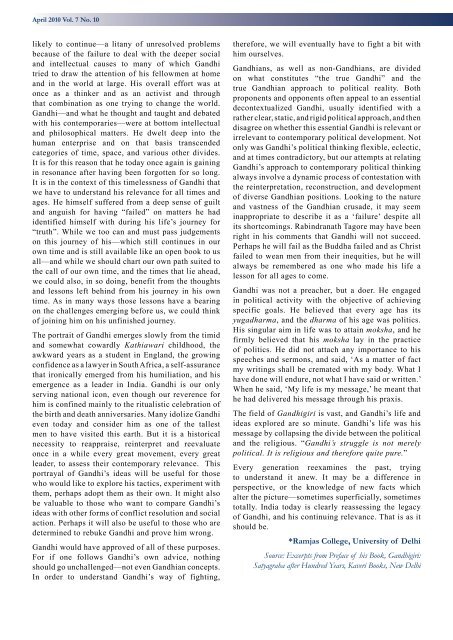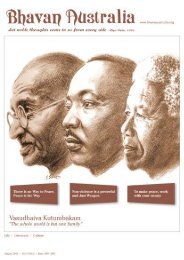'The whole world is but one family' - Bharatiya Vidya Bhavan Australia
'The whole world is but one family' - Bharatiya Vidya Bhavan Australia
'The whole world is but one family' - Bharatiya Vidya Bhavan Australia
Create successful ePaper yourself
Turn your PDF publications into a flip-book with our unique Google optimized e-Paper software.
April 2010 Vol. 7 No. 10<br />
likely to continue—a litany of unresolved problems<br />
because of the failure to deal with the deeper social<br />
and intellectual causes to many of which Gandhi<br />
tried to draw the attention of h<strong>is</strong> fellowmen at home<br />
and in the <strong>world</strong> at large. H<strong>is</strong> overall effort was at<br />
once as a thinker and as an activ<strong>is</strong>t and through<br />
that combination as <strong>one</strong> trying to change the <strong>world</strong>.<br />
Gandhi—and what he thought and taught and debated<br />
with h<strong>is</strong> contemporaries—were at bottom intellectual<br />
and philosophical matters. He dwelt deep into the<br />
human enterpr<strong>is</strong>e and on that bas<strong>is</strong> transcended<br />
categories of time, space, and various other divides.<br />
It <strong>is</strong> for th<strong>is</strong> reason that he today once again <strong>is</strong> gaining<br />
in resonance after having been forgotten for so long.<br />
It <strong>is</strong> in the context of th<strong>is</strong> timelessness of Gandhi that<br />
we have to understand h<strong>is</strong> relevance for all times and<br />
ages. He himself suffered from a deep sense of guilt<br />
and angu<strong>is</strong>h for having “failed” on matters he had<br />
identified himself with during h<strong>is</strong> life’s journey for<br />
“truth”. While we too can and must pass judgements<br />
on th<strong>is</strong> journey of h<strong>is</strong>—which still continues in our<br />
own time and <strong>is</strong> still available like an open book to us<br />
all—and while we should chart our own path suited to<br />
the call of our own time, and the times that lie ahead,<br />
we could also, in so doing, benefit from the thoughts<br />
and lessons left behind from h<strong>is</strong> journey in h<strong>is</strong> own<br />
time. As in many ways those lessons have a bearing<br />
on the challenges emerging before us, we could think<br />
of joining him on h<strong>is</strong> unfin<strong>is</strong>hed journey.<br />
The portrait of Gandhi emerges slowly from the timid<br />
and somewhat cowardly Kathiawari childhood, the<br />
awkward years as a student in England, the growing<br />
confidence as a lawyer in South Africa, a self-assurance<br />
that ironically emerged from h<strong>is</strong> humiliation, and h<strong>is</strong><br />
emergence as a leader in India. Gandhi <strong>is</strong> our only<br />
serving national icon, even though our reverence for<br />
him <strong>is</strong> confined mainly to the ritual<strong>is</strong>tic celebration of<br />
the birth and death anniversaries. Many idolize Gandhi<br />
even today and consider him as <strong>one</strong> of the tallest<br />
men to have v<strong>is</strong>ited th<strong>is</strong> earth. But it <strong>is</strong> a h<strong>is</strong>torical<br />
necessity to reappra<strong>is</strong>e, reinterpret and reevaluate<br />
once in a while every great movement, every great<br />
leader, to assess their contemporary relevance. Th<strong>is</strong><br />
portrayal of Gandhi’s ideas will be useful for those<br />
who would like to explore h<strong>is</strong> tactics, experiment with<br />
them, perhaps adopt them as their own. It might also<br />
be valuable to those who want to compare Gandhi’s<br />
ideas with other forms of conflict resolution and social<br />
action. Perhaps it will also be useful to those who are<br />
determined to rebuke Gandhi and prove him wrong.<br />
Gandhi would have approved of all of these purposes.<br />
For if <strong>one</strong> follows Gandhi’s own advice, nothing<br />
should go unchallenged—not even Gandhian concepts.<br />
In order to understand Gandhi’s way of fighting,<br />
therefore, we will eventually have to fight a bit with<br />
him ourselves.<br />
Gandhians, as well as non-Gandhians, are divided<br />
on what constitutes “the true Gandhi” and the<br />
true Gandhian approach to political reality. Both<br />
prop<strong>one</strong>nts and opp<strong>one</strong>nts often appeal to an essential<br />
decontextualized Gandhi, usually identified with a<br />
rather clear, static, and rigid political approach, and then<br />
d<strong>is</strong>agree on whether th<strong>is</strong> essential Gandhi <strong>is</strong> relevant or<br />
irrelevant to contemporary political development. Not<br />
only was Gandhi’s political thinking flexible, eclectic,<br />
and at times contradictory, <strong>but</strong> our attempts at relating<br />
Gandhi’s approach to contemporary political thinking<br />
always involve a dynamic process of contestation with<br />
the reinterpretation, reconstruction, and development<br />
of diverse Gandhian positions. Looking to the nature<br />
and vastness of the Gandhian crusade, it may seem<br />
inappropriate to describe it as a ‘failure’ despite all<br />
its shortcomings. Rabindranath Tagore may have been<br />
right in h<strong>is</strong> comments that Gandhi will not succeed.<br />
Perhaps he will fail as the Buddha failed and as Chr<strong>is</strong>t<br />
failed to wean men from their inequities, <strong>but</strong> he will<br />
always be remembered as <strong>one</strong> who made h<strong>is</strong> life a<br />
lesson for all ages to come.<br />
Gandhi was not a preacher, <strong>but</strong> a doer. He engaged<br />
in political activity with the objective of achieving<br />
specific goals. He believed that every age has its<br />
yugadharma, and the dharma of h<strong>is</strong> age was politics.<br />
H<strong>is</strong> singular aim in life was to attain moksha, and he<br />
firmly believed that h<strong>is</strong> moksha lay in the practice<br />
of politics. He did not attach any importance to h<strong>is</strong><br />
speeches and sermons, and said, ‘As a matter of fact<br />
my writings shall be cremated with my body. What I<br />
have d<strong>one</strong> will endure, not what I have said or written.’<br />
When he said, ‘My life <strong>is</strong> my message,’ he meant that<br />
he had delivered h<strong>is</strong> message through h<strong>is</strong> prax<strong>is</strong>.<br />
The field of Gandhigiri <strong>is</strong> vast, and Gandhi’s life and<br />
ideas explored are so minute. Gandhi’s life was h<strong>is</strong><br />
message by collapsing the divide between the political<br />
and the religious. “Gandhi’s struggle <strong>is</strong> not merely<br />
political. It <strong>is</strong> religious and therefore quite pure.”<br />
Every generation reexamines the past, trying<br />
to understand it anew. It may be a difference in<br />
perspective, or the knowledge of new facts which<br />
alter the picture—sometimes superficially, sometimes<br />
totally. India today <strong>is</strong> clearly reassessing the legacy<br />
of Gandhi, and h<strong>is</strong> continuing relevance. That <strong>is</strong> as it<br />
should be.<br />
*Ramjas College, University of Delhi<br />
Source: Excerpts from Preface of h<strong>is</strong> Book, Gandhigiri:<br />
Satyagraha after Hundred Years, Kaveri Books, New Delhi









